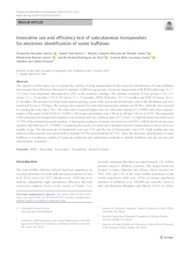Innovative use and efficiency test of subcutaneous transponders for electronic identification of water buffaloes.
Innovative use and efficiency test of subcutaneous transponders for electronic identification of water buffaloes.
Autoria: GARCIA, A. R.; BARROS, D. V.; OLIVEIRA JUNIOR, M. C. M. de; BARIONI JUNIOR, W.; SILVA, J. A. R. da; LOURENÇO JUNIOR, J. de B.; PESSOA, J. dos S.
Resumo: The objective of this study was to evaluate the viability of using transponders for the electronic identification of water buffaloes and compare their efficiency when used in animals of different age groups. Electronic transponders with RFID technology (2.1 × 12.2 mm) were implanted subcutaneously (D0) in the scutiform cartilage. The animals consisted of four groups: CLF-I (17 calves; 2.1 ± 1.9 months), CLF-II (20 calves; 5.1 ± 3.2 months), HFR (20 heifers; 22 ± 4.7 months) and STR (19 steers; 26.6 ± 6.7 months). The animals were kept under pasture grazing, a part of the year in the dryland and a part in the floodplain, and were monitored for up to 350 days. The average time required for individual transponder implant was 49.46 s, while the time required for reading the code was 3.76 s. The older calves required higher time for individual implant (P = 0.0001) and closer approximation of the reader in the D150 (P = 0.0001). The mean read distance was 2.98 cm in D0 and 1.94 cm in D150. The magnitude of the subcutaneous transponder migration was minimal, and was within an area of 17.2 mm2. A slight bleeding was observed in 15.79% of the animals during the implant. A decreasing incidence of edema was observed until D21, with the heifers being more sensitive until that time (P = 0.0099). Considering the results, it is preferred to implant electronic transponders in calves up to two months of age. The physical rate of transponder loss was 1.3% and the loss of functionality was 9.2%. High reading rate was achieved when animals were raised both in dryland (93.9%) and floodplain (97.2%). Thus, the electronic identification of water buffaloes is a technique capable of replacing traditional and rudimentary methods to identify buffaloes and can provide safe identification of animals.
Ano de publicação: 2020
Tipo de publicação: Artigo de periódico
Unidade: Embrapa Pecuária Sudeste
Palavras-chave: Bubalus Bubalis, Food safety, Microchip, RFID, Traceability
Observações
1 - Por padrão são exibidas publicações dos últimos 20 anos. Para encontrar publicações mais antigas, configure o filtro ano de publicação, colocando o ano a partir do qual você deseja encontrar publicações. O filtro está na coluna da esquerda na busca acima.
2 - Para ler algumas publicações da Embrapa (apenas as que estão em formato ePub), é necessário ter, no celular ou computador, um desses softwares gratuitos. Sistemas Android: Google Play Livros; IOS: iBooks; Windows e Linux: software Calibre.
Acesse outras publicações
Acesse a Base de Dados da Pesquisa Agropecuária (BDPA) para consultar o acervo completo das bibliotecas da Embrapa.

